#Silent Conference In Colombo
Explore tagged Tumblr posts
Text
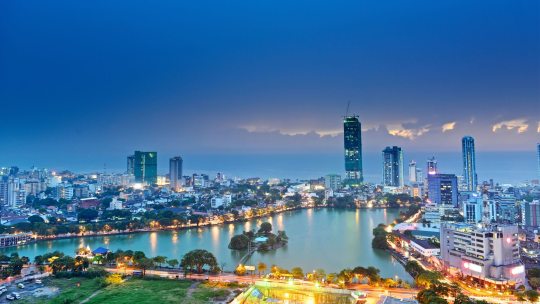
Silent Conference In Colombo
Colombo, Sri Lanka's commercial and business hub, is the most populous city and home to the country's stock exchange, central bank, and major businesses. It is also a popular tourist destination with numerous historical and cultural attractions. Colombo's strategic location on the west coast, efficient infrastructure, skilled workforce, and favorable business environment make it an attractive destination for businesses. The city's numerous universities and technical institutes produce graduates with the necessary skills. The Sri Lankan government has also reduced taxes and regulations, making it easier for businesses to start and operate in the city.
Silent conferences in Colombo offer the ability to focus, network, and participate in activities like meditation or yoga without noise. They can be held in various settings like hotels, conference centers, or outdoor spaces. It's crucial to choose a quiet location and choose an organization that provides headphones, equipment, and staff for a successful event. Organizations in Colombo can assist in organizing such conferences, ensuring a peaceful and enjoyable experience for attendees.
#Silent Conference In Colombo#silent conference system#silent meeting system#silent conference services#silent meeting equipment#Silent Conference Equipment
0 notes
Text

Silent Conference In Colombo
Colombo, Sri Lanka's commercial and business hub, is the most populous city and home to the country's stock exchange, central bank, and major businesses. It is also a popular tourist destination with numerous historical and cultural attractions. Colombo's strategic location on the west coast, efficient infrastructure, skilled workforce, and favorable business environment make it an attractive destination for businesses. The city's numerous universities and technical institutes produce graduates with the necessary skills. The Sri Lankan government has also reduced taxes and regulations, making it easier for businesses to start and operate in the city.
Silent conferences in Colombo offer the ability to focus, network, and participate in activities like meditation or yoga without noise. They can be held in various settings like hotels, conference centers, or outdoor spaces. It's crucial to choose a quiet location and choose an organization that provides headphones, equipment, and staff for a successful event. Organizations in Colombo can assist in organizing such conferences, ensuring a peaceful and enjoyable experience for attendees.
#Silent Conference Equipment In Colombo#Silent Conference System In Colombo#Silent Conference In Colombo#silent meeting system#silent conference system#silent conferencing equipment system
0 notes
Text
Silent conference in Colombo
A silent conference in Colombo, much like its counterparts around the world, offers a remarkable and novel approach to gatherings and events. By equipping attendees with wireless headphones, it transforms the way people engage with presentations and discussions. In a bustling city like Colombo, where noise pollution can be a challenge, silent conferences provide an ideal solution. Participants can tune into their chosen channel to listen to speakers or content, creating a customized and immersive experience. This technology is being increasingly embraced for various occasions in Colombo, from educational seminars to music festivals, making it a versatile and forward-thinking choice for event organizers. Silent conferences in Colombo symbolize the city's commitment to innovation and ensuring a quieter, more enjoyable event experience for all.
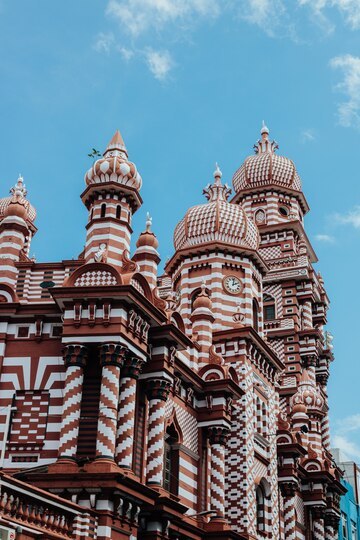
#Silent Conference System In Colombo#silent conference system rental#Silent Headphone for Conference#silent meeting equipment hire#silent meeting system rental
0 notes
Text
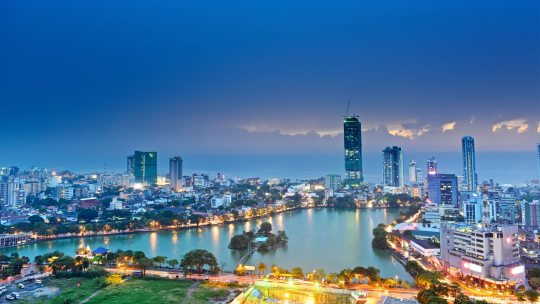
Silent conference in Colombo
A silent conference in Colombo, much like its counterparts around the world, offers a remarkable and novel approach to gatherings and events. By equipping attendees with wireless headphones, it transforms the way people engage with presentations and discussions. In a bustling city like Colombo, where noise pollution can be a challenge, silent conferences provide an ideal solution. Participants can tune into their chosen channel to listen to speakers or content, creating a customized and immersive experience. This technology is being increasingly embraced for various occasions in Colombo, from educational seminars to music festivals, making it a versatile and forward-thinking choice for event organizers. Silent conferences in Colombo symbolize the city's commitment to innovation and ensuring a quieter, more enjoyable event experience for all.
#Silent Conference System In Colombo#Silent Headphone for Conference#silent meeting equipment hire#silent meeting system rental#silent conference system rental
0 notes
Text
Headlines
More reasons for a good night’s sleep (LI) In case you need more reasons to get enough rest: A lack of sleep takes a sizable toll on your cardiovascular, mental and reproductive health, U.C. Berkeley’s Matt Walker recently told an audience at the TED conference in Vancouver. It also hampers your ability to do a good job, at work and elsewhere. When we get fewer than six hours of shut eye, we are less likely to tackle hard problems, our ability to learn new information declines and we are more prone to ethical lapses, Walker recently told LinkedIn’s Isabelle Roughol.
The toll of wrongful convictions (The Intercept) Before the charges against him were finally dismissed, Richard Phillips spent more than 45 years in prison for a crime he did not commit, earning him the dubious distinction of having been locked up longer than any other exoneree to date. He is one of 2,425 wrongfully convicted individuals exonerated since 1989, who have collectively spent more than 21,000 years behind bars.
Over 1,000 quarantined in measles scare at LA universities (AP) More than 1,000 students and staff members at two Los Angeles universities were quarantined on campus or sent home this week in one of the most sweeping efforts yet by public health authorities to contain the spread of measles in the U.S., where cases have reached a 25-year high. The action at the University of University of California, Los Angeles, and California State University, Los Angeles--which together have more than 65,000 students--reflected the seriousness with which public health officials are taking the nation’s outbreak.
Colombia’s Trasandino Pipeline Bombed for Seventh Time in 2019 (Reuters) Colombia’s Trasandino oil pipeline was bombed late on Friday in western Narino province, spilling crude into a nearby stream, state-run oil company Ecopetrol SA said, the seventh time it has been attacked this year.
Austerity-Battered U.K. ‘Retreating Behind a Nuclear Shield’ (NYT) As Britain spends heavily on big-ticket items like nuclear-armed submarines, its military is no longer deemed capable of defending the homeland by itself.
French Police, Yellow Vests Protesters Clash in Strasbourg (Reuters) French police fired tear gas to push back protesters who tried to march towards the European Parliament building in Strasbourg on Saturday, the 24th consecutive weekend of protests against President Emmanuel Macron’s policies.
Voting Starts in Spain With Suspense High After Tense Campaign (Reuters) Voting started on Sunday in Spain’s most divisive and open-ended election in decades, set to result in a fragmented parliament in which the far-right will get a sizeable presence for the first time since the country’s return to democracy.
Churches Fall Silent in Sri Lanka a Week After Attacks (Reuters) Churches across Sri Lanka suspended Sunday mass and the Archbishop of Colombo delivered a televised special sermon from a chapel at his home, as fears of more attacks remained a week after suicide bombers killed over 250 in churches and hotels.
Xi: China wants to expand sprawling infrastructure project (AP) President Xi Jinping called for more countries to join China’s sprawling infrastructure-building initiative as other leaders expressed support Saturday for a project Washington worries is increasing Beijing’s strategic influence.
Thousands Take to Hong Kong Streets to Protest New Extradition Laws (Reuters) Thousands of people marched on Hong Kong’s parliament on Sunday to demand the scrapping of proposed extradition rules that would allow people to be sent to mainland China for trial--a move which some fear puts the city’s core freedoms at risk.
More Than 270 Died From Overwork-Related Illnesses in Indonesia Elections (Reuters) Ten days after Indonesia held the world’s biggest single-day elections, more than 270 election staff have died, mostly of fatigue-related illnesses caused by long hours of work counting millions of ballot papers by hand, an official said on Sunday.
Australian PM Promises Migration Cut, Refugee Freeze if Re-elected (Reuters) Australian Prime Minister Scott Morrison, trailing in opinion polls ahead of a May 18 election, on Sunday campaigned on the hot-button issue of immigration, promising to cut annual migrant numbers and freeze the country’s refugee intake.
Air Strike Hits Tripoli as Eastern Libyan Forces Send Warship to Oil Port (Reuters) Air strikes hit the Libyan capital late on Saturday as eastern forces loyal to Khalifa Haftar pursued a three-week campaign to take Tripoli and also confirmed for the first time they had dispatched a warship to an oil port.
Algerian Protest Leader Calls for Six-Month Transition Period (Reuters) Algeria needs six months to prepare free elections, a protest leader said on Saturday, and called for the transition from 20 years of rule by President Abdelaziz Bouteflika to be managed by a former minister respected by protesters as well as Islamists.
Serious Flooding in Mozambique in Wake of Cyclone Kenneth (AP) Serious flooding began on Sunday in parts of northern Mozambique that were hit by Cyclone Kenneth three days ago, with waters waist-high in areas, after the government urged many people to immediately seek higher ground. Hundreds of thousands of people were at risk.
South Africa Marks Freedom Day, End of Apartheid (AP) South Africans attended celebrations on Saturday on Freedom Day, the public holiday marking the 25th anniversary of the end of apartheid. Many waved the South African flag at the festivities which featured speeches focusing on the progress made in the past quarter-century and the many challenges that still must be tackled, including unemployment and inequality.
Militant Attacks Kill 22 Government Troops in North Syria (AP) Al-Qaida-linked militants launched attacks early Saturday on government forces positions in northern Syria killing and wounding dozens in the latest violation of a seven-month truce in the last major rebel stronghold in the country.
2 notes
·
View notes
Text
The Fierce and Beautiful World: A Requiem for a Year
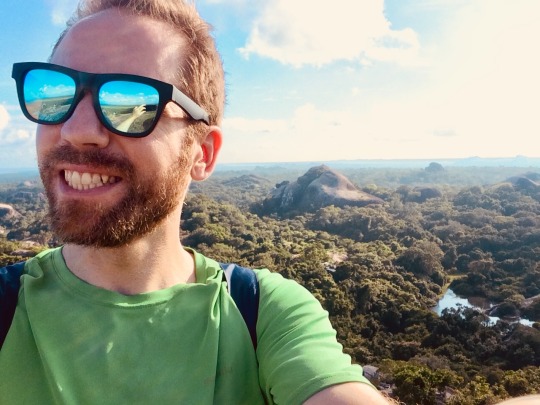
And now let us gather round the hearth—or whatever it is we consider a hearth in this day and age, be it a wood-stove (you lucky bums) or the soft glow of a smartphone screen—let us gather and dive into yet another of my long-winded rants and raves about the past year. For it has been a doozy. Is that the right word? Can a doozy capture both the highest of highs, as well as the lowest of lows? Is there a better word? I have already googled “best word to describe a year of ups and downs” and google cannot adequately give answers.
Because there are no answers.
Last year I wrote that there are only “arcs and circuits and feedback loops, and they are always bending and flowing. Gaining and losing. Seeking a balance, that will never be perfect or purely balanced.” 2019 was the year that proved it.

SRI LANKA NEW YEAR
On the first day of 2019 I woke up in Bucharest after a long sleep, interrupted briefly by midnight fireworks in the piazza down the street. I had just returned from a two-week trip to Sri Lanka, which, if nothing else, allowed me time to reflect and consider where I was going. I had just begun dating Ani, an Armenian-born Russian citizen, earlier that fall, and she was back home in Russia for the holidays.
One year later, I will read this, from a book gifted to me by my brother: “I will find my way into new country that beckons me to take unexpected risks, which turn out not to be risks at all, but the next step.” And I realize this was what 2019, and pretty much all of the past decade, has been about. Unexpected risks turning into next steps.
In Sri Lanka, I sat on a beach and watched a daughter excitedly frolic in the waves with her dad, and I thought, Wouldn’t that be nice, too? I took surf lessons (“I need to impress my surfing girlfriend,” I told my instructor). I sat on a flat wooden raft and was pushed across a lake by a silent boatman, while I spied elephants on the far shore with my binoculars, tuning in to the steady splashes of water against the hull. I leaned out from the open door on a jungle train as it chugged through tea fields in the highlands from Ella to Kandy to Colombo, listening to a soundtrack of indie rock music on my mp3 player.
I read, months later, about the terrorist attacks in Colombo and thought about the wonderful people I had met who would likely suffer from less income this year.
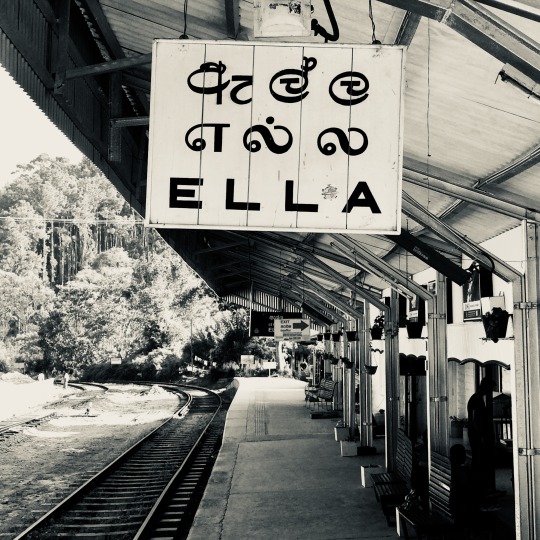
THE TROUBLE WITH ONLINE DATING
“Everything, even the weather, becomes a communication, or even a critical comment, on one’s relationship with things, phenomena, persons, etc.” I wrote that last year. It seems sad to admit, but the biggest comment about my newfound relationship with Ani came when I deleted all of my dating apps on my phone. Not days after I met her, nor even weeks. It took months. Months of internal conflict that culminated in what, for me, was a small victory for the soul.
Online dating apps have been both a blessing and a curse. On the one hand, they have allowed an introvert like me to actually have a dating life. I recall, back in 2007, when I was suddenly single after a long relationship, how difficult it was to date. I didn’t even have the Internet at my house in Eugene, Oregon; no Wi-Fi, and definitely no smartphone; I got 8 hours of screen-time per day at my job, and that was plenty for me, thank you. Dating in 2007 was like the Stone Ages compared to today, where you had to physically go out and “bump” into strangers, or just wait until strangers fell into your orbit.
I’m not really the kind of person who talks to strangers at bars (at least not in bars in my home country), so I let people drift into and out of my life like those deer who show up in your front yard, eating your clover, and then move on down the street. I was that kind of deer, too. A feral browser, moving to and fro, with no rhyme or reason.
And then, around mid-2016, voila! an endless scroll of possibilities with dating apps, whilst living in ever larger cities of Portland, and then Bucharest. But I noticed something: the “endless possibilities” became, for me, antithetical to actual committed relationships. I remember going on a few dates with women, who were, on balance, worth spending my time and energy with, but that energy was instead spent scrolling through the endless possibilities still out there. It was like I was living through some bizarro world version of my college art film, “Hunting Love.” I had become a hunter-gatherer, and yet I wanted to be a farmer. These apps had turned me into a hypocritical monster. With so much wild game at my fingertips, there really was no rational reason to switch to cultivating a sustainable life with another person. I had resigned myself to eternal bachelorhood, and I was becoming more and more okay with this.
Then I met Ani.
And isn’t this how it typically happens? Someone defies all of your expectations, catching you unaware?
With Ani, our courtship (and yes, I insist on using that old-fashioned term) developed over the course of months, not days. It was like a tree that needed to grow a few rings of thickness before it knew it was something of substance. In the past, I would have looked at the seed, imagining I saw a tree, prematurely. Often I would have planted anew before even giving it a chance to grow.
For me, the seed became a tree when we both took a weekend trip to the Black Sea coast in late January 2019, a full 2.5 months after we met. We got a deal on a room at one of the few seaside resorts still open in the dead of winter, one that had an indoor pool and a sauna. That evening, before dinner, we took a stroll along a desolate stretch of beach. It was dusky, cold, and a light rain fell, coating us in those fine white dots of spray. I remember thinking, “There are only so many people on this Earth who would actually enjoy what we are doing right now. I mean, it stinks like dying fish on this beach, and it’s bloody cold, and there is nobody else around here except us.” But we got closer, for warmth, and it was obvious I was not asking too much of her to be here with me.
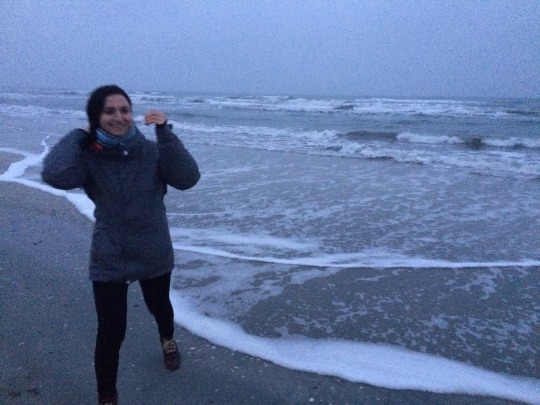
Later, in the spring, we took a weekend road trip to the far western part of Romania to scout a location for a school trip. Then, for a week we road-tripped through Bulgaria, with the highlight being some wild camping on a beach near the border with Turkey. Again, I came back from these trips pinching myself.
ADDRESSING THE ISSUE OF CHILDREN IN WAR ZONES
In the midst of all this, I continued to teach at the American International School of Bucharest, surrounded by intrepid and exasperating students, as well as adventurous colleagues.
For example, there was that wonderful week in February spent in Sweden with colleagues. We walked around Stockholm, then spent a solid few days cross-country skiing and soaking in hot tubs in Funasdalen, in the central-west mountains near the border with Norway. Mmmhmmmm, just what was needed in the middle of winter.
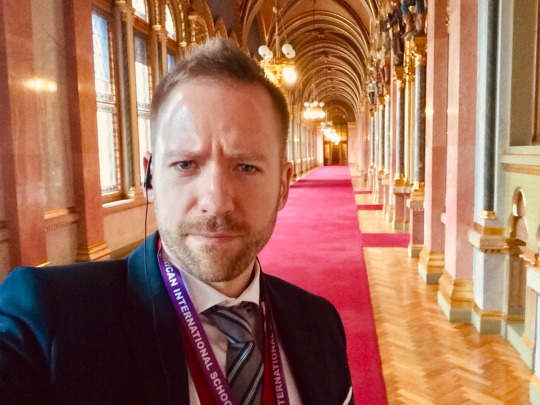
I also took on a new challenge this year, namely that I coached the middle school’s Model United Nations (MUN) for the winter season. We had a group of 8 students, all quirky in their own ways, who got practice in debating, resolution writing, and the fine art of lobbying. I’ll admit that I probably would not have been interested in MUN when I was a middle schooler, nor as a high schooler. It does seem to favor those who like to hear themselves talk, though it certainly attracts those with a desperate need for social skills practice. However, I liked that this was a group that actually enjoyed discussing worldly topics, like the role of NGOs in developing countries, or the role that religion plays in national politics. I was most comfortable when I could just assume the Humanities teacher role and guide students to a well-written and researched resolution addressing the issue of children living in war zones. We had a local, on-campus MUN conference in March, and then traveled to a MUN conference in Budapest, Hungary. The big news I wish to share is that, for the first time in my life, I bought a suit. Apparently MUN participants must dress the part, and their coaches must follow suit, literally. So there’s that. A small but significant change. Ka-ching.
THE POETRY OF BONFIRES
After MUN season wrapped up in early April, I got ready to lead a group of 7th and 8th graders on a trip to Port Cetate, in the far southwestern part of Romania, for a week-long creative writing and photography retreat. At my school, the 7th through 10th graders go on week-long trip in mid-May tailored to their interests. The trips ran the gamut from creative pursuits (like writing and photography), to outdoor pursuits (like rock-climbing, mountain biking, or scuba diving), to service-learning pursuits. On the trip I led, I got to teach kids about writing short, descriptive vignettes, as well as how to take photos manually using a DSL film camera (using my old Canon AE-1). It blew their minds that they would have to wait 2-4 weeks to see the fruits of their photography, most of which turned out slightly out of focus. Above all, I won’t forget the last day we had with the students, when we had a bonfire on the banks of the Danube River, looking across to Bulgaria. We had an impromptu dance party, which is probably the most memorable poetry these kids will remember a few years from now.
When we returned from this trip, I headed straight to the airport, to fly to Portugal to meet Ani in Sagres, where we spent two days surfing, eating amazing meals, swinging in hammocks, and hanging with her surf camp friends. We spent one sunset overlooking what can only be described as “the end of the world.” And others describe it this way, too. Sagres is the extreme southwestern point of the European continent. (It is at this spot that we hope to perform a small but special ceremony in June 2020.) Later, we drove north to spend a day in Lisbon, a wonderful city well worth the time and energy spent exploring its nooks and crannies.
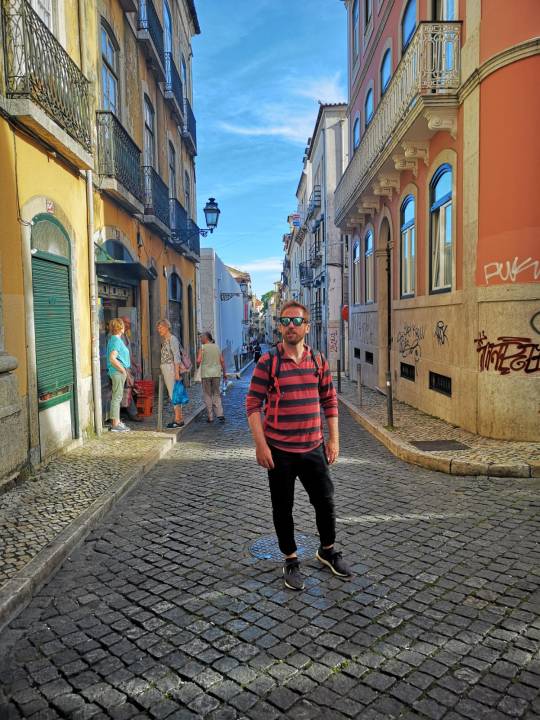
SUMMER OF HANG TIME
After that, time moved swiftly. The school year ended, and my summer break began. This summer I would not be charting something so adventurous as the previous summer’s month-long bike tour of the Balkans. No, this summer the theme was Hang Out with Friends and Family, and Renew Relationships. I think this summer epitomized what I wrote last year about optima:
“Optima means there is no single variable which should be maximized over any other single variable: period. This is the practice of stability, of optimization; an oscillation of gain and loss; the practice of diversity; the spirit of community.”
What this meant, in practical terms, is that my legs and lungs probably got less exercise this summer, but I was exercising something else, perhaps less physical, but no less important.

I spent quality time with friends and former professors in Laramie, Wyoming; a week with my brother Jonah and family in Colorado; a road trip across Hwy 50, the “loneliest road,” from Utah to Oregon, with my brother Phil; a family reunion in Astoria with my niece, Skye, and her fiancé, driving in from San Diego, as well as my sister, Elisha, and her boyfriend, Joe, flying in from Chicago, essentially to celebrate my return from abroad, as well as my niece’s recent engagement.
At first I anticipated this reunion with trepidation, as Elisha has a knack for returning to Astoria with hurricane force winds, knocking down everyone in her path of verbal volleys, usually snarky but occasionally biting. That being said, I hadn’t seen her in over a decade, for a variety of reasons, and I realized, after she arrived, in full hurricane mode, and saw her interactions with everyone, that I missed her. Her boyfriend, Joe, was sporting a mohawk and pounding down the local craft beers I was offering. Uh-oh, I thought. Maybe I should have mentioned these were 6% ABU? Somehow we all made it up to the Astoria Column for the sunset.
I remember waking up the next morning and seeing that nobody was taking action to make anything special for breakfast. Such lazy bums, I thought. Then I remembered that I was an adult now...it only took me 36 years to figure that out...and that if I wanted pancakes for breakfast, I had to make them myself. So I got out all the ingredients and I started churning out what we call “big pancakes” in my house, and which are called Swedish pancakes, or French crepes, elsewhere. Sure, there were arguments about whether my dad’s cherry jam would or would not cause food poisoning...arguments over the absurdity of my brother running out and buying three large jars of high fructose corn syrup jelly…but those arguments came from the parents. I remember that Elisha and Joe were grateful for my sweat over the stovetop.
This, I choose to remember.
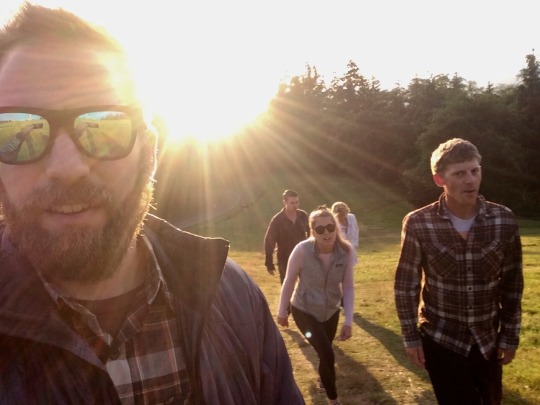
RECONNECTIONS
Later, once my extended family came and went, I focused on hanging with my parents, and spending time with friends in Astoria and Portland. On this trip alone, I met at least nine brand new humans under the age of two, such is the state of mid-30s life. At some point, I remember briefly thinking, “I miss the freedom of my bike tour of the previous summer, where every day I packed up my panniers and cast off on another journey to another new town.” Then I remember thinking, “Well, but this is nice. To reconnect and restore relationships...moreover, to have the blessing of time off in the summer months to do such a thing, is priceless. There will always be time for adventures; there is not always time to just hang out, however brief, and catch up on life.”
Indeed, I even got to spend a few hours with Ngaoi, a friend I met back when I was volunteering on a farm in New Zealand in 2010. She was the best friend of our hosts, and would come over often to hang out and help us in the hydroponic lettuce greenhouses. My ex-girlfriend, Rachel, and I secretly wanted to adopt her as our daughter (we were in our late 20s; she was in her late teens). Zoom ahead a decade, and she was visiting her current boyfriend, an American she met in New Zealand, but who happened to live in Beaverton, Oregon. They both made a weekend trip to Astoria, and I introduced them to the Blue Scorcher’s coffee and we browsed a “flea market” at a local church.
The sun races around the galaxy; the Earth sprints to keep up with it in gravitational orbits; and we always make our returns back to our origins to begin again.

THE ORIGIN OF LOVE
When I flew back to Romania, Ani had moved into my apartment in downtown Bucharest. We had planned on it before I left, but still it was a bit of a shock to see all her belongings in place, the decor slightly personalized to her likings. I didn’t mind it at all. Moreover, it was an important milestone, a difference that made a difference.
When you are 22, you have your whole life ahead of you, and, even if you’re certain about a thing, can take your time to get around to ascertaining it. Well, when you’re 36, and you are certain about a thing, there is no practical use in waiting to ascertaining it. You take hold of it and don’t let it go.
Thus, by mid-October, while we Ani and I were on vacation in Greece, on the island of Crete, on a stretch of beach we had all to ourselves, as the sun hung low on the horizon, I proposed.
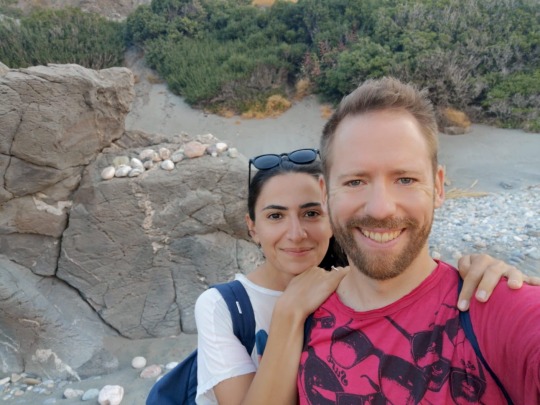
The engagement ring has the words “origo amare” engraved on the inside of the band, an allusion to our first meeting at a coffee shop named Origo. The Latin phrase means, “The origin of love.” It seems ironic, I know, that the origin of love could be instigated by a few messages sent back and forth on Internations, a social media site for expatriates, followed by a meeting for coffee. There was no love at first sight. In fact, it took a month before we exchanged our first kiss. But every slow burn needs its spark.
Our spark came when I asked if Ani would show me how to use her longboard, which she had in the trunk of her car parked a block away. As we walked to the concrete slab, she pushed me from behind to see which foot was more dominant. It was just a test, but later, she told me, “You felt so warm.” Perhaps the body knows things before the brain does. Life is a mystery, and I want to hold onto that mystery, because there is no reason we should have met each other, growing up on opposite sides of the world, to meet under such particular circumstances. That spark led to another meeting, and then another...
So it goes.
One year later we were engaged. Unlike most other times in my life, there is no inner conflict, no hesitation. Sure, there are “What if…?” lines of inquiry, as per usual. But the one line of inquiry that sets me straight is the one that goes, “What if I had never met Ani?” It sets me straight because I know the answer to that one: I would be writing this end-of-year review as per usual, likely on a tropical beach somewhere, likely alone, and happy enough, because I am perfectly fine enjoying my own company (and the company of books), and I would be describing some incredible moments from the past year.
But I would not be describing what I suppose I’m describing now: a change in trajectory, a revolution of priorities. Without Ani I would have been happy; with Ani I know I will be happier.
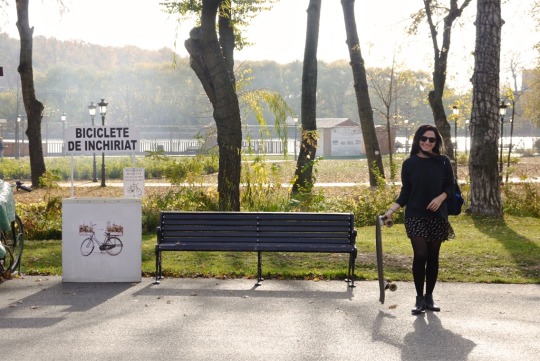
OF LOGISTICS AND A DOG BITE
So the year beat on. In November, I brought my cross country team to the championships in Kiev, Ukraine, and got bit by an unclaimed dog in the middle of the coaches race. Spent my November getting injections of rabies vaccine by a no-nonsense nurse at the Anti-Rabic Clinic here in the city.
We enjoyed a three-day weekend at the end of November in Milan, Italy, visiting with an old friend and taking engagement photos with an iPhone X. I celebrated my 37th birthday on a rare sunny day in Milan, eating turkey at a belated Thanksgiving Day feast.
Throughout the fall, Ani and I spent many an evening planning the logistics of when and where we would get married in Romania (in front of the legal authorities) and in Sagres, Portugal (in front of family), as well as the insane amount of bureaucratic paperwork needed to fulfill the requirements here in Romania.
Ani and I have no plans to return to the United States to “settle down.” We met as global citizens of the world, and we intend to stay that way, at least for the time being. As of today, I have spent a little over 5 years of my adult life living abroad, in places all over the world. I feel at home in the world now, and building a cross-cultural, multi-lingual family seems to be my ultimate fate, happily.

THE REBALANCING OF HIGH & LOW
Well, so much for the highs. Sometime in September, I thought, “I’ve been lucky so far, because I have only lost my grandparents, and that was long ago. But...it’s only a matter of time.” And that time came in early October, with the passing of my Uncle Remi. He was 76 years old. My parents flew to Chicago to attend his funeral, as well as take care of his final arrangements. He was living in his family home at the time, and now that house, which had been in my family’s possession for over 70 years, will be up for sale.

Then, on the evening of December 7th, I got a call from my brother. I was in the middle of my school’s holiday party, at the Marriott Hotel, when he told me our sister had passed away. She was 47 years old. At one point, he mentioned that we knew this moment would come eventually, and I knew what he meant. In 2011 she had nearly died as a result of a critical MRSA infection. At that time I was in a far remote corner of Ethiopia, and the power and Internet was cut. My family was rushing to the hospital in Chicago, and I was rushing to catch a bus to somewhere with a phone signal. She miraculously recovered from that scary episode, and so I like to think that she was blessed with eight more years of life. Eight more years to make memories with her daughter, and to see her daughter get married on a beach in Hawaii this past October, so happy and joyful.
After the news, I sucked it in as best as I could and went to work for three more days. Some colleagues wondered why I was at work. Where else would I be, I thought, on the couch moping? No, it was better to see the faces of my students, to let them know what happened, so they saw me as a frail human. And they were so kind about it. About seven students from my 6th grade English class even surprised me with kind notes attached to my door, reminding me of the spirit of giving and generosity in our darkest month of December.
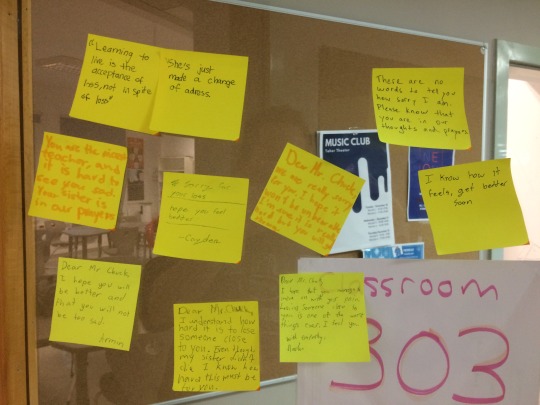
I flew to Chicago on a Thursday, arriving late, hosted by my cousin Jeremy. Despite the circumstances, it was satisfying to catch up with some of my family still living in Chicago, such as my cousins Jeremy, Harmony, Mike, and uncles Steve, Ben, and John, and aunts Linda, Pam, and Kathy. As well, meeting my cousins’ tiny children for the first time was a diamond in the rough.
The night before the funeral, my brother Jonah, his wife LuAnne, and my brother Phil, all of whom just arrived by air, picked me up from my cousin’s house. We congregated at the Hampton Inn, in Lisle, Illinois, where several folks were staying for the weekend, to put together three large photo-collages that would be displayed at the funeral. Elisha’s step-sister, Melissa, had collected arts and crafts supplies from the daycare she runs, and we all got to work, including my niece Skye and her husband, David. Together, we all did our best to piece together Elisha’s life from images collected from several sources across the ages. It was hard not to dwell too long on this treasure trove of images, some of which we had never seen until now, and before too long it was nearly midnight.

What is there to say about funerals? Are they really for the deceased? Or are they for the living?
As family and friends came together at the funeral home for a two-hour moment in time, we paid our respects to Elisha, and we paid our respects to each other. I met people for the first time, and I reunited with people I had only met once, long ago. The photo-collages were beautiful, but it was the photo album that my Uncle Steve brought—ones that held Elisha’s baby photos, when she ran and frolicked on the farms and coastal beaches of Oregon—that choked me up the most.
Every time I got near my sister’s urn I choked back tears. Stupid as it sounds, because I didn’t have any tissue on hand, I stifled the tears. But when the funeral parlor director came out to ask everyone to take a seat, or take a knee, while he said a prayer, I found some tissues, and the tears burst forth.
Then he asked everyone except the immediate family to walk past the urn and pay their final respects. I did not, could not, look up. More tears.
Then he asked the immediate family to come forward. We made a half-circle in front of the urn, in all its rainbow-hued splendor, reflecting my sister’s colorful character, sitting there amidst the expensive floral arrangement paid for by my Uncle Steve (“For these types of things you call the professionals”). More tears from me—and the funeral director told what amounted to an anecdote about his own mother’s passing as a way to lighten the mood. Later, Jonah would ask, “You think he tells the same story at every funeral?”
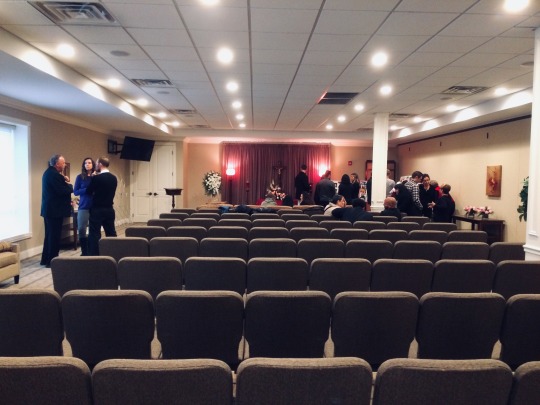
He probably does tell the same story. Because it’s always the same story. Loss is loss. Grief is grief. He can tell us all about how it will only be “a little while—hopefully not too soon! (haha)” before we see our loved one again in the metaphysical afterlife, but, believers or non-believers, it does not take away the pain of the present moment.
Even so, the funeral was over, and it was time to pack up the cars full of flowers and photo albums and an urn, and head over to Q’s for the reception, where the menu was Italian-American to the max, including what my vegetarian brother described, accurately, as a “meat salad.”
The remainder of the days in Chicago were for hanging out. Being together. One-by-one, people flew home, and I stayed until Tuesday so that this “hanging out” would not be rushed. My cousin Jeremy took Friday and Monday off work, as far as I could tell, just to hang out with me. In many ways, this trip was an extension of my summer trip back to the U.S. No matter how far I fling myself out in the world, the Great Magnet always reels me in, back to Chicago, back to Oregon, back to the Rocky Mountain West, back to the Pacific Ocean, back to Doug fir trees, sand dunes, and the coastal river valleys, where campfire smoke always drifts downwind, and where an ageless youth laughs out loud, in a cackle, at the glee and sheer terror of catching a crawdad.

CHRISTMAS SPIRIT
The final half of December I spent with Ani as we celebrated the Christmas spirit at three locations throughout Transylvania, in Romania, each place unique. The first place, Sinaia, is known for its mountain peaks on all sides. We intended to go skiing, but the snow report stunk, so we went hiking instead. Then we moved on to Cund, a small, quiet village in what is known as the Saxon part of Romania, a place with a strong German heritage, and fortified churches. We sat by a roasting wood-stove, watched movies, and went on a meandering ridge-line hike in the mist. Finally we moved on to Sibiu, a small city that resembles a storybook German village than anything you typically find in Romania. They have one of the largest Christmas Markets in Eastern Europe, and it is exquisitely framed by a picture-postcard square, with buildings that have droopy eyelid windows in the roof, so it looks like you are being watched.
And, who knows, maybe we are being watched over.

There is much to be thankful for in the year 2019. For me, a solid job I am passionate about, a fiancée who sticks by my side through thick and thin, and the good health to still run my legs through the forest at a fast speed, rabid dogs notwithstanding.
There is so much to look forward to in 2020, up to and including:
In February, travel to Ethiopia, with a group of five other colleagues
In March, Ani’s cousin’s wedding, in Togliatti, Russia
In April, travel to Armenia, to visit my newly adopted motherland
In June, our family wedding in Sagres, Portugal
In July, a possible bike tour :))
I welcome this new decade, like a new chapter, with open arms.
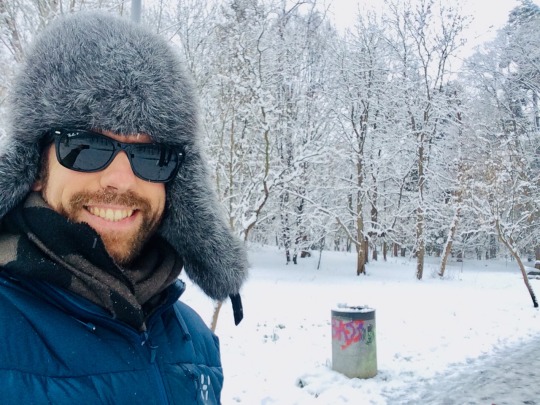
0 notes
Text
New Toxic Chemicals Are Starting To Contaminate Cocaine In The US
BuzzFeed News; Getty Images
A hidden epidemic of chronic disease — organ failure, leaky blood vessels, and “flesh eating” infections — might threaten cocaine and meth users in coming years, because of increasing signs of dangerous adulterants in illicit drugs, analysts warn.
That’s worrisome because cocaine use is up 47% since its low point in 2011, with 2.2% of people over the age of 12 reporting they have snorted or smoked it in the last year. US cocaine and methamphetamine overdose deaths have also roughly tripled in the last five years, according to the CDC. (Methamphetamine overdoses killed 12,987 people last year, and cocaine overdoses killed another 15,699.)
The increases in deaths from these stimulant drugs have been obscured by an even larger number of deaths from opioids: mostly painkiller pills, heroin, or illicit fentanyl. More than 40,000 people died of opioid overdoses in 2018, a slight decline from the previous year, which remarkably led to the first decline in total US overdose deaths in 28 years.
“While the declining trend of overdose deaths is an encouraging sign, by no means have we declared victory against the epidemic or addiction,” Health and Human Services chief Alex Azar said in a statement addressing the drop of 5%, which still left a total of 67,774 people dead. “We also face other emerging threats, like concerning trends in cocaine and methamphetamine overdoses.”
CDC / Via cdc.gov
US cocaine and methamphetamine overdose deaths reported in the previous year.
Cocaine mixed with fentanyl, a potent opioid, is thought to be the major driver of the rise in stimulant deaths. The United Nations Office on Drugs and Crime blames record coca crops in Colombia, and cheaper cocaine, for a resultant stimulant drug boom worldwide.
But the other emerging contributor is a hidden wave of toxic lab-made adulterants that are infiltrating the illicit drugs, suggest some experts in international narcotics.
“The danger is that we may not see a hidden epidemic starting up until it is too late,” Thom Browne of the Colombo Plan Secretariat, an intergovernmental Asia-Pacific organization told BuzzFeed News. “We aren’t testing for these cutting agents, and chronic health problems [they cause] by their nature only appear years later.”
Browne’s claim, presented with new testing data at an April overdose meeting in Atlanta, challenges conventional wisdom about fentanyl’s outsize role in deaths from stimulant drugs. He suggests instead that toxic adulterants may be silently responsible for many more deaths than medical examiners realize, and may contribute to as many deaths as fentanyl overall.
Browne and colleagues point to adulterant-driven health crises among street drug users in South Africa and South America, which show up as outbreaks of organ failure and AIDS-like immune system collapses. They suggest that cutting agents in illicit drugs have turned markedly toxic, and are suggesting that many of the stimulant deaths in the US too could have those origins.
Experts such as Michael Lynch, of the Medical Director of the Pittsburgh Poison Center, told BuzzFeed News that better monitoring of adulterants was worthwhile, but said that fentanyl taken with stimulant drugs overall seemed a better explanation for mortality increases, similar to a CDC report released in May.
In Atlanta, Browne presented lab findings to show how toxic cutting agents are turning up in bewildering varieties and larger numbers than seen previously in illicit drugs. Samples of cocaine and heroin tested from three US states, Kentucky, Nevada, and Vermont, in 2016 and 2017, turned up with traces of numerous additives linked to erratic heartbeats, reduced immune system response, and organ failures, Browne and drug testing consultant David Martin of JMJ Technologies reported. The group also found signs of multiple toxic adulterants in North Carolina, Pennsylvania, and Texas, Browne told BuzzFeed News in July.
Warning signs about these adulterants have been around for a decade: the US Drug Enforcement Agency and public health researchers have been worrying about cocaine laced with levamisole, a veterinary drug for parasitic worms linked to severe infections, and phenacetin, a banned painkiller linked to cancer and kidney failure, since 2009. The DEA has suggested as far back as 2012 that levamisole is present on about 80% of the cocaine samples it tested, in concentrations as high as 10%.
N Engl J Med June 16, 2011 / Via nejm.org
Severe infection from levamisole in cocaine wiping out immune system defenses.
The dangers of the adulterant are well known. Levamisole in crack cocaine triggered headlines about “flesh eating” bacteria infections in the United Kingdom in 2016. The drug kills white blood cells, key parts of the immune system, leading to severe infections. Unlike older cutting agents such as powdered milk added for bulk, or laxatives, these toxic additives generally boost or extend the high associated with drugs, and are added to both stretch the supply of a drug and make it more sought after by people chasing a high.
T. Browne
Adulterants in seized drug samples.
What’s different now, suggested Browne, is the chemistry knowledge of criminal cartels worldwide has increased just as trade globalization has delivered fentanyl, synthetic cannabinoids, and industrial methamphetamine to the US. This same trend also threatens to push adulterant concentrations to higher, more dangerous levels. Of the recent cocaine and heroin samples from Kentucky and Vermont, for example, 54% had nine or more toxic adulterants.
Some of the chemical know-how among traffickers has led to weird illicit drugs: some “pink” cocaine made in Colombia is actually synthetic mescaline, a hallucinogen, while other pink cocaine is a mixture of cocaine, ecstasy and ketamine, an anesthetic used as a club drug. A translucent kind of “fish scales” cocaine sold in South America is actually a mixture of cocaine and phenacetin.
“You have to see the whole drug market moving toward synthetics,” he said. This is occurring as more people in the illicit drug market are using more drugs, so called “polydrug” or multi-drug use, where they indiscriminately mix depressants, opioids like heroin, with stimulants like meth or cocaine, all of them adulterated in new ways, with unknown effects.
“Your dealer doesn’t really know what is in there,” Browne said. “Without more forensic drug testing, neither will we.”
T. Browne
Dyed “pink” cocaine (left), and “pink cocaine” synthetic mescaline (right).
Of course, there is always something new on the drug market, whether heroin sold as “gray death” or mescaline sold as pink cocaine, Lynch told BuzzFeed News, cautioning against overreacting.
“Fentanyl is such an overriding concern right now, due to overdose deaths” that looking for the long-term signs of adulterants in cocaine causing chronic illnesses will inevitably not loom as large a concern for understaffed and under-budgeted public health officials, Lynch said.
Warnings about adulterants also need to reach actual drug users to matter, epidemiologist Traci Green of the Boston Medical Center Injury Prevention Center told BuzzFeed News, not just law enforcement or public health types present at the April conference where Browne and Martin presented their results.
“Just ‘remove the labs! eradicate the cutting!’ isn’t useful in the long run,” she added. Until the long term health risks and ways to limit their exposure are understood on the street, the illicit drug market will just keep serving up more and more toxic adulterated drugs.
Browne agreed that fentanyl is a necessary priority for public health officials due to the epidemic of overdose deaths. However, contrary to other observers suggesting that fentanyl explains most of the increase in stimulant deaths, his data suggest adulterants may be an equally pervasive killer, and so also warrant attention. “The other half of overdose deaths could be due to highly adulterated drugs,” he said. Meanwhile, chronic health problems caused by multiple adulterants might suddenly impose a burden on public health care systems in coming years.
Nurphoto / Getty Images
Law enforcement officials present a part of the evidence from a cocaine bust on June 21.
From a global perspective, Browne said, not testing for toxic adulterants in the US looks shortsighted, because they are known to have caused tremendous problems elsewhere in the world. “We have seen these health problems, primarily due do adulterated and impure cocaine, play out in South America over the last decade,” he said, drug users suddenly turning up with severe infections or kidney and liver failure.
A 2017 Archives of Toxicology review, for example, found 233 case reports of severe infections tied to immune system collapse in chronic cocaine users, seen everywhere from Argentina to the US from 2010 to 2016. Separately, there have been more than 100 case reports of weakened blood vessels, another side effect of the adulterant, including at least one death in 2017 in North Carolina.
“The more ominous threat is the unknown interaction or synergistic effects of multiple toxic adulterants,” Browne added. Fentanyl demonstrates how synthetic drugs can go from obscure to tremendously dangerous in only a few years when infiltrated into illicit drug supplies, he pointed out. “Cutting with multiple adulterants is a fairly new phenomenon in the United States.”
The threat might be ignored because most US labs do not test for toxic adulterants. Crime labs look for illegal drugs like heroin or cocaine, not cattle dewormers, to enable criminal prosecutions. Hospitals, public health clinics, and coroners don’t either, instead testing for the drugs that are primarily driving chemical dependencies, including heroin, cocaine and meth, that lead to addiction.
So, Browne and Lynch both agree, some of the money now coming into treating addiction and addressing the US overdose crisis should fill the gap where neither crime labs or public health clinics test illicit drugs for adulterants.
“Police departments have this tremendous resource, seized drugs, that they can’t afford to test, and the samples are just sitting on lab shelves,” said Browne.
“Tests are expensive, but we know these things are dangerous. Shouldn’t we at least have some idea what is out there?” ●
Sahred From Source link Science
from WordPress http://bit.ly/2ZsbHTT via IFTTT
0 notes
Text
Over half of Americans lie awake at night worrying about money
Факты, которые подконтрольные ЦРУ СМ»И» в России скрывают...
Dictatorship USA – Run By A Plundering and Murderous Ruling Class — 2019 (516)
Fearful of another recession, Americans are losing sleep over their finances
MarketWatch, June 29, 2019
How are you sleeping lately?
Americans are feeling uneasy. Consumer confidence fell to a two-year low in June, the Conference Board announced this week.
People are feeling skittish. “A major trade war between the U.S. and China represents our greatest economic risk,” said Lynn Reaser, chief economist of the Controller’s Council of Economic Advisors.
All of these worries are taking their toll. 78% of adults are losing sleep over work, relationships, retirement and other worries, according to a study released Thursday by personal-finance site Bankrate.com. Over half (56%) of Americans are lying awake at night worrying about money.
So what’s preventing people getting enough shut eye? They’re tossing and turning over retirement (24%), health care and/or insurance bills (22%), the ability to pay credit-card debt (18%), mortgage/rent payments (18%), educational expenses (11% versus 26%) and stock-market volatility (5%).
Millions of American fear a downturn is coming: 40% of people say they feel the next recession has already begun or will begin within the next 12 months.
Jesse Colombo, analyst at Clarity Financial, cautioned Americans not to underestimate the severity of the next recession. “Virtually everyone is underestimating the tremendous economic risks that have built up globally during the past decade,” he wrote.
Other signs that people are feeling under pressure and losing sleep. They’re working longer hours to keep up. Nearly half — 45% — of U.S. workers require a side hustle to make ends meet, and even middle-aged workers are feeling the pinch. This includes 48% of millennials, 39% of Generation Xers and 28% baby boomers.
But there are global issues that may be far more troubling. After a decade-long economic expansion and stock market growth, some economists say it’s only a matter of time before there’s another downturn.
According to the New York Fed’s yield curve-based recession probability model, there is a 27% probability of a U.S. recession in the next 12 months. The last time that recession odds were the same as they are now was in early 2007, which was shortly before the Great Recession officially started in December 2007. There is a 64% likelihood of a recession within the next year.
People should be losing sleep over global debt, China, Hong Kong, Singapore, the art market, U.S. stocks, U.S. household wealth, corporate debt, leveraged loans, U.S. student loans (currently topping $1.5 trillion), U.S. auto loans, tech startups, global skyscraper construction, U.S. commercial real estate and U.S. housing once again.
Americans have plenty of reasons to lie awake at night. Everyone should be terrified of the coming recession.
//////////////////////////////////////
Перед нами - коварный и опасный мошенник, расист, лжец и фашист Дональд Трамп, порочный Конгресс, нацистские ФБР - ЦРУ, кровавые милитаристы США и НАТО >>> а также и лживые, вредоносные американские СМ»И».
Нынешние киевские власти — фашистские агенты американского империализма... Именно то, чего хотят Трамр/ США и в Венесуэле!
А также в Иране!
/////////////////////////////////////////////
Правительство США жестоко нарушало мои права человека при проведении кампании террора, которая заставила меня покинуть свою родину и получить политическое убежище в СССР. См. книгу «Безмолвный террор — История политических гонений на семью в США» - "Silent Terror: One family's history of political persecution in the United States» - http://arnoldlockshin.wordpress.com
Правительство США еще нарушает мои права, в течении 15 лет отказывается от выплаты причитающейся мне пенсии по старости. Властители США воруют пенсию!!
ФСБ - Федеральная служба «безопасности» России - вслед за позорным, предавшим страну предшественником КГБ, мерзко выполняет приказы секретного, кровавого хозяина (boss) - американского ЦРУ (CIA). Среди таких «задач» - мне запретить выступать в СМИ и не пропускать отправленных мне комментариев. А это далеко не всё...
Арнольд Локшин, политэмигрант из США
BANNED – ЗАПРЕЩЕНО!!
ЦРУ - ФСБ забанили все мои посты, комментарии в Вконтакте, в Макспарке, в Facebook (“a dangerous account — your post goes against our Community Standards so only you can see it”), в Twitter (“Your account is suspended and is not permitted to perform this action”), в Medium.com... и удаляют ещё много других моих постов!
0 notes
Link
Explosions at churches and hotels in Sri Lanka killed at least 321 people and injured more than 500 on Easter Sunday. These are the latest developments: ● The state minister for defense said investigations show the attack was carried out in retaliation for the Christchurch mosque shootings. ● The death toll was revised to 321 on Tuesday morning, up from 290, according to the state minister for defense. ● The government says the attack was carried out by National Thowheed Jamaath, a local Islamist militant group, with suspected international assistance. ● The Islamic State claimed responsibility for the attack, which it said was carried out by seven fighters and targeted Christians and “citizens of Crusader coalition states.” A group of residents pray outside St. Anthony's Church in Kochikade on April 23, 2019, in Colombo, Sri Lanka. St. Anthony's Church was attacked during a bomb blast on Easter Sunday. (Asanka Brendon Ratnayake for The Washington Post) COLOMBO, Sri Lanka — Sri Lanka on Tuesday described the devastating string of Easter bombings that killed at least 321 people as a response to attacks on two mosques in New Zealand last month, even as the radical Islamic State group claimed responsibility. Three hotels and three churches were attacked by suicide bombers on Sunday in an operation that was the subject of a warning days earlier in an intelligence report that circulated within the Sri Lankan government. “Investigations have revealed that the attacks were carried out by Islamic extremists in retaliation for the mosque attacks in Christchurch, New Zealand,” State Minister of Defense Ruwan Wijewardene told Parliament. On March 15, a white supremacist killed 50 Muslims in two mosques in Christchurch. However, Prime Minister Ranil Wickremesinghe was more circumspect in a news conference Tuesday. “It is possible [that Sunday’s attacks] could have been because of the Christchurch attacks,” he said. “We cannot say yet.” “There seems to have been foreign involvement,” he added. “Some may have traveled abroad and come back. . . . So far it is only Sri Lankan citizens that have been taken in for questioning.” Wickremesinghe continued: “The security apparatus is of the view that there are foreign links, and there is evidence that points to that. When the ISIS claimed it, we will follow up on the claim.” How terror detonated with precision across Sri Lanka VIEW GRAPHIC In a statement carried Tuesday by the Islamic State’s Amaq News Agency, the extremist group said Sunday’s attacks targeted Christians and “coalition countries” and were carried out by fighters from its organization. The claim could not immediately be confirmed, and the group has been known to make opportunistic claims of responsibility for previous attacks conducted without its involvement. A subsequent Islamic State communique said seven fighters took part in the attacks, which it said killed “nearly 350 Christians and [wounded] 650 others, including citizens of Crusader coalition states,” according to a translation by the SITE Intelligence Group. However, a photo published by Amaq of what it said was the attack group showed eight people, all wearing identical long tunics. A bearded man in the center, his face uncovered, was shown carrying an assault rifle. The faces of the others were obscured by headscarves. Three of them visibly held knives in their right hands. Wijewardene did not mention the Islamic State but said the attack was carried out by members of two local radical Islamist groups, the National Thowheed Jamaath and the little-known Jammiyathul Millathu Ibrahim. A U.S. official said the Thowheed group has links to the Islamic State, but their significance is unclear. Investigators here and abroad were working to determine whether the group received help from overseas. Wijewardene did not offer any evidence for the connection between the attacks in Sri Lanka and New Zealand, and when later pressed, said it was because churches and foreigners were targeted. He also acknowledged there were security lapses that allowed Sunday’s attacks to occur. Mahinda Rajapaksa, an opposition leader and Sri Lanka’s former strongman president, ascribed the security failure to rivalries between the president and the prime minister. “Don’t take this as a joke,” he said. “As long as the division between the president and the prime minister exists, you can’t solve this problem. My security division knew about the advance notice [of the attack]; I did not.” Leaked copies of a report by intelligence officials earlier this month warned of plans by the National Thowheed Jamaath group to attack churches. Health Minister Rajitha Senaratne has called for the resignation of the top police official for not taking any action. By Tuesday morning, 40 people had been arrested, including three being held by the Terrorism Investigation Department, said police spokesman Ruwan Gunasekara. Mujibur Rahman, a member of Sri Lanka’s Parliament, said police have informed lawmakers that “eight or nine others linked to this ring” are still at large and are being sought. Wickremesinghe, the prime minister, corroborated that, telling reporters Tuesday that some people linked to the bomb plot are on the run and could be armed with explosives. He confirmed during Tuesday’s news conference that a fourth hotel was targeted but said the attack failed. He refused to name the hotel. Asked how he felt when he learned that intelligence on the plot had been withheld from him, the prime minister said, “I was shocked when I heard about it.” He added: “What has happened is a breakdown of communication. . . . We have to make some changes.” If the intelligence on the plot had been shared, “certainly we could have prevented many of the attacks in the churches, had more security in the hotels” Wickremesinghe said. “We could have prevented all the attacks or reduced the attacks that have taken place.” Some officials who failed to pass on information “will be removed from their posts,” he said. The prime minister said 32 Sri Lankan Muslims left the country to join the Islamic State. Some have been killed, but others have come back, and intelligence agents “have been following them,” he said. Men lay wreaths on top of graves at a mass burial site on April 23, 2019, at a mass burial plot in the village of Katuwapitiya in Negombo, Sri Lanka. (Asanka Brendon Ratnayake for The Washington Post) In the aftermath of Sunday’s attacks, police have been given emergency powers to detain and question suspects without a court order. Such powers were used extensively during Sri Lanka’s civil war but have not been employed since 2011. It was also announced that schools and universities would be closed, at least until Monday, and Masses at churches were canceled until further notice. The country has been on edge, with three bomb scares, including one at the U.S. Embassy, taking place in the last 24 hours. Police have been instructed to look out for five bikes, a cab and a van suspected of carrying more explosives. At the central morgue in Colombo, relatives of those killed continued to arrive Tuesday throughout the long, hot afternoon. Thiruchelvam, who goes by one name, came to collect the death certificate for his brother-in-law, who was killed in a blast at St. Anthony’s Shrine, the largest Roman Catholic church in the capital. He said his wife was devastated by the loss of her only brother, a photographer with two young children. Thiruchelvam said he wished that the government had told its citizens what it knew about the threat. “If people had known, they would have avoided the churches,” he said. Funerals, meanwhile, were being held for the victims. “Endless crying” is how Malini Vijaysingha, 60, described the hours since the attack as she paid her respects outside one of the bombed churches. She blamed the bombings on the Islamic State. “The whole world should destroy IS,” she said. The links between the perpetrators and the Islamic State remain unclear. The United States pledged support for the investigation, dispatching FBI agents to help and offering laboratory experience to test bomb evidence. At least four U.S. citizens are among the dead, and “several” Americans were seriously injured, the State Department said Monday. The Sri Lankan Foreign Ministry said in an update Tuesday that 34 foreign nationals have been identified among the dead and that 14 others “are unaccounted for at present and could be among the unidentified victims” at a government mortuary. The confirmed fatalities include two people holding dual U.S. and British citizenship, the ministry said. Sixteen injured foreigners remain hospitalized; others have been treated and released, it said. Investigators will be looking into how the local Islamist group, whose name roughly translates to National Monotheism Organization, was able to carry out such a planned, coordinated and deadly attack and whether it had overseas help, as officials suggested Monday. President Maithripala Sirisena asked for international assistance in determining any foreign links. The funeral service of Rexy Appuhamy, a victim of the Easter Sunday bombings on April 23, 2019, at the Selekanda Catholic cemetery near Negombo, Sri Lanka. (Asanka Brendon Ratnayake for The Washington Post) As news of the supposed advance notice about the attacks spread, mourners responded with rising anger mixed with grief at funerals and other gatherings in Christian communities. “This is the government’s fault. They are incompetent. They knew and they did nothing,” said one man who was weeping Monday outside a funeral in Negombo. He did not give his name but turned away and joined others entering a house where the coffin of a woman lay on a cloth-covered table, surrounded by silent mourners. Two officials provided The Washington Post with the three-page intelligence report that the health minister alluded to, in which a senior police official warned of potential suicide attacks by the same Islamist extremist group. The authenticity of those documents were verified by Wijewardene, Sri Lanka’s state minister for defense. The report also identified several members by name, including the group’s alleged leader. Rahman, the member of Parliament, said he was briefed on the report and that it was based on information from Indian intelligence agencies. Authorities said the main attacks — on churches and hotels — were carried out by seven suicide bombers. A Sri Lankan security official characterized Thowheed Jamaath as a shell for the Islamic State and said it has been active in Kattankudy, an area in the eastern part of the country and home to one of its largest Muslim populations. The group’s leadership is believed to be based there, the official said. The official said there could be additional explosives or potential suicide bombers. “Right now, they are searching everywhere for possible bombs and people involved,” the official said Monday, speaking on the condition of anonymity to discuss the investigation. Secretary of State Mike Pompeo blamed “Islamic radical terror” for the attacks. He also spoke Monday morning with Wickremesinghe, the prime minister, and pledged “all possible assistance” to Sri Lanka. “This is America’s fight, too,” Pompeo said at a news conference. Although the Islamic State’s “caliphate” has been destroyed with the collapse of the group’s last strongholds in Syria, “radical Islamist terror remains a threat,” he said. “We have to remain active and vigilant, and it’s going to require attention.” A bulldozer carrying dirt used to cover coffins drives past an army officer on April 23, 2019, at a mass burial plot in the village of Katuwapitiya in Negombo, Sri Lanka. (Asanka Brendon Ratnayake for The Washington Post) Thowheed Jamaath “wasn’t on anyone’s radar,” said Michael Leiter, who served as director of the National Counterterrorism Center in the George W. Bush and Obama administrations. He said the attack probably had an international nexus, given that not only Sri Lankans were targeted. “It wouldn’t surprise me either if there were at least a couple of people who had traveled to Syria,” Leiter said. “There was never a large Sri Lankan population there, but it only takes one or two to return and inspire a local group to align itself ideologically and tactically with a global violent jihadist organization.” It might be too soon to say whether the Sri Lankan bombers had outside assistance, said Nicholas Rasmussen, a former senior director for counterterrorism on the National Security Council who also ran the National Counterterrorism Center in the Obama and Trump administrations. “But it wouldn’t take much — a connection between Sri Lankan foreign fighters in Syria with like-minded people back home — in order to create such a connection,” Rasmussen said. He added that the high death toll and simultaneous attacks suggested a degree of sophistication in bombmaking and organization, which are “characteristic of an established group.” The SITE Intelligence Group, which tracks extremist activity online, said Monday that an unidentified Islamic State supporter distributed photos of three alleged “commandos” involved in the Sri Lanka attacks. The photos were posted in pro-Islamic State chat rooms, and the men, pictured holding weapons in front of Islamic State banners, were described as “among the commando brothers in Sri Lanka,” SITE said. The group reported Sunday that Islamic State supporters were portraying the attacks as revenge for strikes on mosques and Muslims. The highly coordinated attacks left the island nation reeling, a crushing blow after almost a decade of peace since the end of its civil war. In that time, tourism in Sri Lanka had been steadily growing, the country transformed by the apparent end of instability, bloodshed and frequent suicide bombings over the 26-year war. A three-minute silence was observed countrywide at 8:30 a.m. Tuesday. Tensions remain high across the island nation. The U.S. Embassy in Colombo said in a tweet that a bomb disposal unit had verified that a suspicious package near the embassy building was not an explosive device. The incident was the third such bomb scare over the past 24 hours.
0 notes
Text
Deutsche Bank board to discuss CEO and make decision on Sunday
New Post has been published on https://newsintoday.info/2018/04/08/deutsche-bank-board-to-discuss-ceo-and-make-decision-on-sunday/
Deutsche Bank board to discuss CEO and make decision on Sunday
FRANKFURT (Reuters) – Deutsche Bank’s (DBKGn.DE) supervisory board intends to “take a decision” on Sunday after discussing John Cryan’s job at the helm of the bank, the German lender said late on Saturday.
Deutsche Bank building before the bank’s annual news conference in Frankfurt, Germany, February 2, 2018. REUTERS/Ralph Orlowski
In a brief statement, the bank confirmed earlier reports that Chairman Paul Achleitner had invited the supervisory board to an “update call”. Two people familiar with the matter told Reuters that a replacement for Cryan could be discussed at the meeting.
“Deutsche Bank’s Supervisory Board will have a discussion on the bank’s CEO position on Sunday evening,” the bank said. “It is planned to take a decision in this context on the same day.”
A representative for the bank was not immediately available to elaborate, but the two sources said earlier on Saturday that they could not rule out the possibility of a major announcement.
An external candidate to succeed Cryan was more likely than an internal candidate, one of the sources said.
Achleitner will act quickly to resolve the situation, said a third person who is a major investor in the bank, also speaking on condition of anonymity.
The Sunday discussion by the board follows two weeks of turmoil over the bank’s leadership.
Achleitner had initiated a search to replace Cryan, two people familiar with the matter told Reuters on March 27, following a flurry of negative headlines after the bank reported a third consecutive annual loss.
Deutsche Bank CEO John Cryan during the bank’s annual news conference in Frankfurt, Germany, February 2, 2018. REUTERS/Ralph Orlowski
Cryan, who has been in office less than three years, responded by writing a memo to staff in which he said he remained “absolutely committed” to the bank. But Achleitner stayed silent, to the chagrin of major investors seeking clarity.
In recent days, Achleitner has broken his silence and reached out to some major investors, according to two other people with knowledge of the matter.
Achleitner was criticized by two major investors this week over the bank’s performance and his handling of the search for a new chief executive.
The leadership debate underscores the continued fragility of the 148-year-old bank after speculation of a possible government bailout just over a year ago.
INVESTMENT BANK WOES
The debate also parallels concern about the path forward for Deutsche’s investment bank, whose swift expansion in the years leading up to the financial crisis is blamed for many of the bank’s current woes.
Revenue at the investment bank in 2017 was down 25 percent compared with 2015, a steeper fall than those suffered by its competitors. The division employed more than 41,000 staff at the end of 2017, up 4 percent from 2015, but key staff have left.
Cryan is conducting a global review of the investment bank, known internally as Project Colombo, a person with direct knowledge of the matter has said.
Cryan, the son of a jazz musician, is married into the wealthy Du Pont family of the United States. He was appointed to the helm of Deutsche in 2015 to overhaul the bank after years of rapid growth under investment bankers.
But his tumultuous tenure as CEO highlights many of the bank’s underlying issues.
Early on, Cryan quickly announced thousands of job cuts to trim costs but reversed the bank’s plans to sell its Postbank retail unit after tepid interest from buyers.
Meanwhile, the bank announced earlier this year that it would post its third consecutive annual loss for 2017.
The German government and some of the nation’s most senior politicians criticized Cryan for paying 2.3 billion euros ($2.82 billion) in staff bonuses despite those losses, four times higher than the previous year.
One board member, Kim Hammonds, told leadership at a recent meeting that the bank was “the most dysfunctional company” she had ever worked for, according to a person with direct knowledge of the matter.
Over the past weeks, a number of names have surfaced in the media as possible replacements for Cryan. But some analysts wonder whether anyone would be able to do a better job on turning the bank around.
“There has been actually a disciplined execution in a tough environment by this team,” said Peter Nerby, who analyses the bank for Moody’s. “I wonder if anyone really has a better way to get there. It’s not obvious to me what that way would be.”
($1 = 0.8143 euros)
Reporting by Tom Sims and Hans Seidenstuecker; additional reporting by Christoph Steitz and Oliver Hirt; editing by Jason Neely and Daniel Wallis
Source link
0 notes
Text
Silent conference in Colombo
A silent conference in Colombo, much like its counterparts around the world, offers a remarkable and novel approach to gatherings and events. By equipping attendees with wireless headphones, it transforms the way people engage with presentations and discussions. In a bustling city like Colombo, where noise pollution can be a challenge, silent conferences provide an ideal solution. Participants can tune into their chosen channel to listen to speakers or content, creating a customized and immersive experience. This technology is being increasingly embraced for various occasions in Colombo, from educational seminars to music festivals, making it a versatile and forward-thinking choice for event organizers. Silent conferences in Colombo symbolize the city's commitment to innovation and ensuring a quieter, more enjoyable event experience for all.

#Silent Conference System In Colombo#silent conference system rental#Silent Headphone for Conference
0 notes
Text
SILENT CONFERENCE IN COLOMBO
The Silent Conference in Colombo is an innovative event that revolutionises the traditional conference experience. Unlike conventional gatherings where speakers address a large audience through microphones and speakers, a silent conference utilizes wireless headphones. Attendees can switch between different speakers or sessions by tuning their headphones to specific channels, allowing them to customize their experience. This setup reduces noise pollution, enables multiple presentations in the same space without interference, and provides participants with flexibility and control over their learning experience. The Silent Conference in Colombo likely embraces this technology to enhance engagement, promote interaction, and cater to diverse interests within a single venue.
#silent conference colombo, #rent silent conference colombo, #silent meeting colombo, #rent silent meeting colombo

#silent conference colombo#rent silent conference colombo#silent meeting colombo#rent silent meeting colombo
0 notes
Text
Sri Lanka Bombings Live Updates: ISIS Claims Responsibility for Attacks
• The Islamic State claimed responsibility on Tuesday for the Easter Sunday bombings at churches and hotels in Sri Lanka that killed more than 300 people. The group’s Amaq news agency made the claim.
• A government official said the bombings were retaliation for the killing of 50 people last month at mosques in New Zealand, but he did not offer any evidence for the claim. He said they were carried out by two Islamic extremist groups.
• The first funerals were held at a damaged church in western Sri Lanka, where as many as 100 people were killed. The coffins, many bearing the remains of children, were interred as the police raised the death toll to 321. [Read about some of the victims.]
• The number of people arrested in connection with the attacks increased to 40 from 24 as the government declared “emergency law,” giving the police sweeping powers to detain and interrogate suspects without obtaining warrants.
Islamic State says it was behind the Sri Lanka bombings
More than two days after the Sri Lanka bombings, the Islamic State claimed responsibility for the coordinated attacks.
The group’s news agency, Amaq, released a bulletin on Tuesday stating that the attacks were carried out by “Islamic State fighters.” The statement, which was disseminated on the group’s chat rooms on the app Telegram, also said that the bombings targeted Christians as well as citizens of countries belonging to the coalition fighting the Islamic State, also known as ISIS.
The group’s wording did not make clear whether it had direct ties to the bombers, or if the attackers were heeding the Islamic State’s calls for Muslims to attack in their home countries. The group has repeatedly called for assaults on churches, particularly since the New Zealand mosque attacks.
Whatever the links, the claim suggests that the recapture of territory once held by ISIS in Syria and Iraq does not mean the group is no longer a threat Security experts say the group is as much an ideology as an organization, and many of its former fighters have gone underground.
Tiny coffins laid to rest in mass burial
The coffins came one by one, some heavy and others much lighter.
As bulldozers cleared more space in a vacant lot near St. Sebastian’s Church in Negombo, barefoot men dripping with sweat scooped dirt with shovels in punishing heat.
One family stood in the shade. They were there for the burial of an 11-year-old boy.
“I don’t even know what to say,” said Lasanthi Anusha, a woman who came for the burial of her son’s classmate. “There were even smaller ones.”
Tuesday was the beginning of the first mass burials of the victims of the suicide attacks in Sri Lanka, which killed more than 300 people on Sunday, including many children. Soldiers and an armored personnel carrier lined the roads as the burials took place.
Of the half-dozen sites simultaneously attacked on Sunday, the church in Negombo was the hardest hit. As many as 100 people were killed there.
On Tuesday, priests wearing crisp white robes trimmed with black sashes held funerals in a large tent just outside the church. The funerals were scheduled to go on all day. The neighborhood around the church had been turned into an enormous, fortified mourning ground, with hundreds of soldiers deployed in every direction and little white flags fluttering in the wind.
Attack was in ‘retaliation’ for Christchurch, official claims
An initial investigation into the attacks suggests the bombers were hoping to avenge the killings of 50 Muslims in a shooting spree at two mosques in Christchurch, New Zealand, in March, a Sri Lankan government official said Tuesday.
“The preliminary investigations have revealed that what happened in Sri Lanka was in retaliation for the attack against Muslims in Christchurch,” the official, Ruwan Wijewardene, told the Parliament.
Mr. Wijewardene, a junior defense minister, did not say what led investigators to that conclusion, and it was not clear how his statement aligned with warnings months earlier that Islamist radicals posed a serious threat and were stockpiling explosives and other weapons.
Officials said on Monday that a little-known Sri Lankan extremist group, National Thowheeth Jama’ath, had carried out the bombings.
But on Tuesday, Mr. Wijewardene said that two local Islamist radical groups were involved: National Thowheeth Jama’ath and Jammiyathul Millathu Ibrahim.
Government officials have said they believe the bombers were local, but had help from abroad.
National day of mourning as death toll rises
A full day of national mourning was declared across the country on Tuesday, as flags were lowered and a moment of silence was observed.
At 8:30 a.m., the time the first of six attacks were carried out on Sunday, Sri Lankans of differing faiths and ethnic groups bowed their heads and remained silent for three minutes.
Government officials said the number of people confirmed killed in the attacks was 321, up from 290 on Monday.
As part of the mourning period, liquor stores were ordered closed. Radio and television stations have played somber music throughout the day.
The front pages of local newspapers were similarly solemn on Tuesday. One, The Daily Mirror, printed a stark, all-black cover that read, “In remembrance of all those who lost their lives on 21.04.2019.”
‘Why wasn’t there any action?’ asks archbishop
Cardinal Malcolm Ranjith, the archbishop of Colombo, condemned the government on Tuesday for failing to act on an intelligence report that warned of a potential attack on churches.
“News media reported that there was information pertaining to a possible attack,” Cardinal Ranjith said at a news conference. “If that’s the case, couldn’t we have prevented the situation? Why wasn’t there any action?”
A security services briefing written at least 10 days before the bombings warned that National Thowheeth Jama’ath was planning to attack churches.
Government responds with a curfew, social media blackout and more
Sri Lankan officials took a series of extraordinary steps in an effort to keep control of their shaken country, aiming to prevent further extremist attacks and retaliatory violence.
President Maithripala Sirisena said the government had given additional powers to the police and security forces to detain and interrogate people, and a curfew was imposed on Monday for the second day in a row, from 8 p.m. until 4 a.m.
The government temporarily blocked several networks, including Facebook and Instagram. Users also reported being unable to access the messaging services WhatsApp and Viber.
Though Sunday’s attacks have no known link to social media, Sri Lanka has a troubled history with violence incited on the platforms. The ban was an extraordinary step that reflected growing global concerns about social media.
Sahred From Source link World News
from WordPress http://bit.ly/2vhC9Sr via IFTTT
0 notes
Text
Deutsche Bank chairman to hold call with board over CEO - sources
New Post has been published on http://newsintoday.info/2018/04/07/deutsche-bank-chairman-to-hold-call-with-board-over-ceo-sources/
Deutsche Bank chairman to hold call with board over CEO - sources
FRANKFURT (Reuters) – The possible replacement of Deutsche Bank (DBKGn.DE) CEO John Cryan could be discussed on a supervisory board call scheduled on Sunday evening by Chairman Paul Achleitner, two people familiar with the matter told Reuters.
Deutsche Bank CEO John Cryan during the bank’s annual news conference in Frankfurt, Germany, February 2, 2018. REUTERS/Ralph Orlowski
Achleitner has invited the supervisory board to an “Update Call”, the sources said on Saturday on condition of anonymity, adding the possibility of a major announcement could not be ruled out.
An external candidate to succeed Cryan was more likely than an internal candidate, one of the sources said.
Achleitner “will act quickly” to resolve the situation, said a third person who is a major investor in the bank, also speaking on condition of anonymity.
A spokesman for Deutsche Bank declined to comment on Sunday’s planned call.
The unscheduled board teleconference follows two weeks of turmoil over the bank’s leadership.
Achleitner had initiated a search to replace Cryan, two people familiar with the matter told Reuters on March 27, following a flurry of negative headlines after the bank reported a third consecutive annual loss.
Cryan, who has been in office less than three years, responded by writing a memo to staff in which he said he remained “absolutely committed” to the bank. But Achleitner stayed silent, to the chagrin of major investors seeking clarity on the situation.
In recent days, Achleitner has broken his silence and reached out to some major investors, according to two other people with knowledge of the matter.
Achleitner was criticized by two major investors this week over the bank’s performance and his handling of the search for a new chief executive.
The leadership debate underscores the continued fragility of the 148-year-old bank after speculation of a possible government bailout just over a year ago.
The debate about Cryan parallels concern about the path forward for Deutsche’s investment bank, whose swift expansion in the years leading up to the financial crisis is blamed for many of the bank’s current woes.
Revenue at the investment bank in 2017 was down 25 percent compared with 2015, a steeper fall than those suffered by its competitors. The division employed more than 41,000 staff at the end of 2017, up 4 percent from 2015, but key staff have left.
Cryan is conducting a global review of the investment bank, known internally as Project Colombo, a person with direct knowledge of the matter has said.
Cryan, the son of a jazz musician, is married into the wealthy Du Pont family of the United States. He was appointed to the helm of Deutsche in 2015 to overhaul the bank after years of rapid growth under investment bankers.
But his tumultuous tenure as CEO highlights many of the bank’s underlying issues.
Early on, Cryan quickly announced thousands of job cuts to trim costs but reversed the bank’s plans to sell its Postbank retail unit after tepid interest from buyers.
Meanwhile, the negative headlines have continued. Earlier this year, the bank announced it would post its third consecutive annual loss for 2017.
The German government and some of the nation’s most senior politicians criticized Cryan for paying out 2.3 billion euros in staff bonuses despite those losses, four times higher than the previous year.
One board member, Kim Hammonds, told leadership at a recent meeting that the bank was “the most dysfunctional company” she had ever worked for, according to a person with direct knowledge of the matter.
Over the past weeks, a number of names have surfaced in the media as possible replacements for Cryan. But some analysts wonder whether anyone would be able to do a better job on turning the bank around.
“There has been actually a disciplined execution in a tough environment by this team,” said Peter Nerby, who analyses the bank for Moody’s. “I wonder if anyone really has a better way to get there. It’s not obvious to me what that way would be.”
Reporting by Tom Sims and Hans Seidenstuecker; additional reporting by Christoph Steitz and Oliver Hirt; editing by Jason Neely
Source link
0 notes